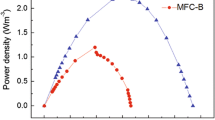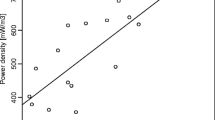Abstract
The combined influence of iron and calcium salts can increase the voltage and power of MFC systems using Saccharomyces cerevisiae as biocatalyst, but no systematic studies were performed. To explore these incomplete understood interactions, the production of bioelectricity has been studied in two types of dual-chambered MFC systems: in small volume batch system with frit as separator and in a medium volume batch system with nafion. In both MFC experiments, CaCO3 and FeSO4 were added as supplements in a modified medium. In the MFC experiment with frit, the highest OCV (1.143 V) was recorded at about 8 h, while in the MFC experiment with nafion, the highest OCV (1.128 V) was recorded at about 132 h, values which are attributable to the above-mentioned mineral salts and exceeding the OCV value of 0.847 V reported in the literature, thus, to our knowledge, higher than any OCV ever recorded from one single MFC operated in batch mode. The power density in the MFC experiment with frit was 1.031 W m− 2, being in concordance with the best literature values. The power densities in the MFC experiment with nafion were lower but increased over time, while the high OCV values were more stable over longer time periods. Overall, the experimental data showed the potential of Saccharomyces cerevisiae in generation of bioelectricity in different MFC configurations.
Graphical abstract






Similar content being viewed by others
References
Franks AE, Nevin KP (2010) Microbial fuel cells, a current review. Energies 3(5):899–919. https://doi.org/10.3390/en3050899
Santoro C, Arbizzani C, Erable B, Ieropoulos I (2017) Microbial fuel cells: from fundamentals to applications. A review. J Power Sources 356:225–244. https://doi.org/10.1016/j.jpowsour.2017.03.109
Logan BE, Wallack MJ, Kim K-Y, He W, Feng Y, Saikaly PE (2015) Assessment of microbial fuel cell configurations and power densities. Environ Sci Technol Lett 2(8):206–214. https://doi.org/10.1021/acs.estlett.5b00180
Lovley DR (2006) Bug juice: harvesting electricity with microorganisms. Nat Rev Microbiol 4(7):497–508. https://doi.org/10.1038/nrmicro1442
Venkata Mohan S, Velvizhi G, Annie Modestra J, Srikanth S (2014) Microbial fuel cell: critical factors regulating bio-catalyzed electrochemical process and recent advancements. Renew Sustain Energy Rev 40:779–797. https://doi.org/10.1016/j.rser.2014.07.109
Logan BE, Hamelers B, Rozendal R, Schröder U, Keller J, Freguia S, Aelterman P, Verstraete W, Rabaey K (2006) Microbial fuel cells: methodology and technology. Environ Sci Technol 40(17):5181–5192. https://doi.org/10.1021/es0605016
Zhang CP, Li MC, Liu GL, Luo HP, Zhang RD (2009) Pyridine degradation in the microbial fuel cells. J Hazard Mater 172(1):465–471. https://doi.org/10.1016/j.jhazmat.2009.07.027
Franks AE, Nevin KP, Jia HF, Izallalen M, Woodard TL, Lovley DR (2009) Novel strategy for three-dimensional real-time imaging of microbial fuel cell communities: monitoring the inhibitory effects of proton accumulation within the anode biofilm. Energy Environ Sci 2(1):113–119. https://doi.org/10.1039/b816445b
Lu N, Zhou SG, Zhuang L, Zhang JT, Ni JR (2009) Electricity generation from starch processing wastewater using microbial fuel cell technology. Biochem Eng J 43(3):246–251. https://doi.org/10.1016/j.bej.2008.10.005
Dheilly A, Linossier I, Darchen A, Hadjiev D, Corbel C, Alonso V (2008) Monitoring of microbial adhesion and biofilm growth using electrochemical impedancemetry. Appl Microbiol Biotechnol 79(1):157–164. https://doi.org/10.1007/s00253-008-1404-7
Donovan C, Dewan A, Heo D, Beyenal H (2008) Batteryless, wireless sensor powered by a sediment microbial fuel cell. Environ Sci Technol 42(22):8591–8596. https://doi.org/10.1021/es801763g
Dumas C, Mollica A, Feron D, Basseguy R, Etcheverry L, Bergel A (2008) Checking graphite and stainless anodes with an experimental model of marine microbial fuel cell. Bioresour Technol 99(18):8887–8894. https://doi.org/10.1016/j.biortech.2008.04.054
Franks AE, Nevin KP, Glaven RH, Lovley DR (2010) Microtoming coupled to microarray analysis to evaluate the spatial metabolic status of Geobacter sulfurreducens biofilms. ISME J 4(4):509–519. https://doi.org/10.1038/ismej.2009.137
Luo HP, Liu GL, Zhang RD, Jin S (2009) Phenol degradation in microbial fuel cells. Chem Eng J 147(2–3):259–264. https://doi.org/10.1016/j.cej.2008.07.011
Zhu XP, Ni JR (2009) Simultaneous processes of electricity generation and p-nitrophenol degradation in a microbial fuel cell. Electrochem Commun 11(2):274–277. https://doi.org/10.1016/j.elecom.2008.11.023
Liu H, Logan BE (2004) Electricity generation using an air-cathode single chamber microbial fuel cell in the presence and absence of a proton exchange membrane. Environ Sci Technol 38(14):4040–4046. https://doi.org/10.1021/es0499344
You S-j, Zhao Q-l, Jiang J-q (2006) Biological wastewater treatment and simultaneous generating electricity from organic wastewater by microbial fuel cell. Huan Jing Ke Xue 27(9):1786–1790
Yuan H, Hou Y, Abu-Reesh IM, Chen J, He Z (2016) Oxygen reduction reaction catalysts used in microbial fuel cells for energy-efficient wastewater treatment: a review. Mater Horiz 3(5):382–401. https://doi.org/10.1039/C6MH00093B
Feng Y, Wang X, Logan BE, Lee H (2008) Brewery wastewater treatment using air-cathode microbial fuel cells. Appl Microbiol Biotechnol 78(5):873–880. https://doi.org/10.1007/s00253-008-1360-2
Galvez A, Greenman J, Ieropoulos I (2009) Landfill leachate treatment with microbial fuel cells; scale-up through plurality. Bioresour Technol 100(21):5085–5091. https://doi.org/10.1016/j.biortech.2009.05.061
Patil SA, Surakasi VP, Koul S, Ijmulwar S, Vivek A, Shouche YS, Kapadnis BP (2009) Electricity generation using chocolate industry wastewater and its treatment in activated sludge based microbial fuel cell and analysis of developed microbial community in the anode chamber. Bioresour Technol 100(21):5132–5139. https://doi.org/10.1016/j.biortech.2009.05.041
Freguia S, Teh EH, Boon N, Leung KM, Keller J, Rabaey K (2010) Microbial fuel cells operating on mixed fatty acids. Bioresour Technol 101(4):1233–1238. https://doi.org/10.1016/j.biortech.2009.09.054
Morris JM, Jin S (2008) Feasibility of using microbial fuel cell technology for bioremediation of hydrocarbons in groundwater. J Environ Sci Health A 43(1):18–23. https://doi.org/10.1080/10934520701750389
Permana D, Rosdianti D, Ishmayana S, Rachman SD, Putra HE, Rahayuningwulan D, Hariyadi HR (2015) Preliminary investigation of electricity production using dual chamber microbial fuel cell (DCMFC) with Saccharomyces cerevisiae as biocatalyst and methylene blue as an electron mediator. Procedia Chem 17:36–43. https://doi.org/10.1016/j.proche.2015.12.123
Rahimnejad M, Ghoreyshi AA, Najafpour GD, Younesi H, Shakeri M (2012) A novel microbial fuel cell stack for continuous production of clean energy. Int J Hydrogen Energy 37(7):5992–6000. https://doi.org/10.1016/j.ijhydene.2011.12.154
An J, Kim B, Chang IS, Lee H-S (2015) Shift of voltage reversal in stacked microbial fuel cells. J Power Sources 278:534–539. https://doi.org/10.1016/j.jpowsour.2014.12.112
Oh SE, Logan BE (2007) Voltage reversal during microbial fuel cell stack operation. J Power Sources 167(1):11–17. https://doi.org/10.1016/j.jpowsour.2007.02.016
Lobo FL, Wang X, Ren ZJ (2017) Energy harvesting influences electrochemical performance of microbial fuel cells. J Power Sources 356:356–364. https://doi.org/10.1016/j.jpowsour.2017.03.067
Yahiro AT, Lee SM, Kimble DO (1964) Bioelectrochemistry: I. enzyme utilizing bio-fuel cell studies. Biochim Biophys Acta 88(2):375–383. https://doi.org/10.1016/0926-6577(64)90192-5
Kováč L (1985) Calcium and Saccharomyces cerevisiae. Biochim Biophys Acta 840(3):317–323. https://doi.org/10.1016/0304-4165(85)90211-9
Rogowska A, Pomastowski P, Złoch M, Railean-Plugaru V, Król A, Rafińska K, Szultka-Młyńska M, Buszewski B (2018) The influence of different pH on the electrophoretic behaviour of Saccharomyces cerevisiae modified by calcium ions. Sci Rep 8(1):7261. https://doi.org/10.1038/s41598-018-25024-4
Park DH, Zeikus JG (2000) Electricity generation in microbial fuel cells using neutral red as an electronophore. Appl Environ Microbiol 66(4):1292–1297. https://doi.org/10.1128/aem.66.4.1292-1297.2000
Holmes E, Loo RL, Stamler J, Bictash M, Yap IKS, Chan Q, Ebbels T, De Iorio M, Brown IJ, Veselkov KA, Daviglus ML, Kesteloot H, Ueshima H, Zhao LC, Nicholson JK, Elliott P (2008) Human metabolic phenotype diversity and its association with diet and blood pressure. Nature 453(7193):396. https://doi.org/10.1038/Nature06882
Li-ping Fan SX (2016) Overview on electricigens for microbial fuel cell. Open Biotechnol J 10:398–406
Eliato TR, Pazuki G, Majidian N (2016) Potassium permanganate as an electron receiver in a microbial fuel cell. Energy Sources A 38(5):644–651. https://doi.org/10.1080/15567036.2013.818079
Logan BE (2008) Voltage generation. In: Logan BE (ed) Microbial fuel cells. Wiley, Hoboken, pp 29–43. https://doi.org/10.1002/9780470258590.ch3
Fan YZ, Hu HQ, Liu H (2007) Enhanced Coulombic efficiency and power density of air-cathode microbial fuel cells with an improved cell configuration. J Power Sources 171(2):348–354. https://doi.org/10.1016/j.jpowsour.2007.06.220
Samsudeen N, Radhakrishnan TK, Matheswaran M (2015) Performance comparison of triple and dual chamber microbial fuel cell using distillery wastewater as a substrate. Environ Prog Sustain Energy 34(2):589–594. https://doi.org/10.1002/ep.12005
Ghasemi M, Halakoo E, Sedighi M, Alam J, Sadeqzadeh M (2015) Performance comparison of three common proton exchange membranes for sustainable bioenergy production in microbial fuel cell. Procedia CIRP 26:162–166. https://doi.org/10.1016/j.procir.2014.07.169
Acknowledgements
This study was performed within the frame of ROM-EST project, Code SMIS-CSNR: 48706 and project PN 16 36 11972. We are grateful to Dr. Mihaela Ramona Buga for useful discussions and support.
Author information
Authors and Affiliations
Corresponding authors
Electronic supplementary material
Below is the link to the electronic supplementary material.
Rights and permissions
About this article
Cite this article
Badea, SL., Enache, S., Tamaian, R. et al. Enhanced open-circuit voltage and power for two types of microbial fuel cells in batch experiments using Saccharomyces cerevisiae as biocatalyst. J Appl Electrochem 49, 17–26 (2019). https://doi.org/10.1007/s10800-018-1254-7
Received:
Accepted:
Published:
Issue Date:
DOI: https://doi.org/10.1007/s10800-018-1254-7




